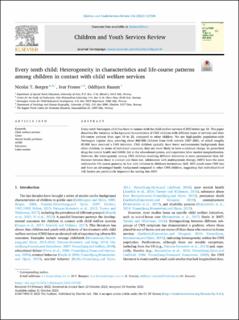| dc.contributor.author | Borgen, Nicolai T. | |
| dc.contributor.author | Frønes, Ivar | |
| dc.contributor.author | Raaum, Oddbjørn | |
| dc.date.accessioned | 2024-02-05T09:11:24Z | |
| dc.date.available | 2024-02-05T09:11:24Z | |
| dc.date.created | 2023-11-23T16:50:02Z | |
| dc.date.issued | 2023 | |
| dc.identifier.citation | Children and Youth Services Review. 2023, 155 1-10. | en_US |
| dc.identifier.issn | 0190-7409 | |
| dc.identifier.uri | https://hdl.handle.net/11250/3115473 | |
| dc.description.abstract | Every tenth Norwegian child has been in contact with the child welfare services (CWS) before age 18. This paper
describes the variation in background characteristics of CWS children with different types of services and their
life-course patterns from ages 10 to 25, compared to other children. We use high-quality population-wide
Norwegian register data, covering about 860 000 children from birth cohorts 1987–2001, of which roughly
85 000 have received a CWS initiative. CWS children typically have lower socioeconomic backgrounds than
other children. In terms of individual outcomes, they are more likely to have a criminal charge, be prescribed
drugs for mental health and ADHD, fail in the educational system, and experience labor market marginalization.
However, the heterogeneity among CWS children receiving different initiatives is more pronounced than dif-
ferences between those in contact and those not. Adolescents with multisystemic therapy (MST) have the most
unfavorable life-course patterns, in line with children in childcare institutions. Still, MST youth enter CWS late
and have an advantaged family background compared to other CWS children, suggesting that individual-level
risk factors are particularly important for sorting into MST. | en_US |
| dc.language.iso | eng | en_US |
| dc.rights | Navngivelse 4.0 Internasjonal | * |
| dc.rights.uri | http://creativecommons.org/licenses/by/4.0/deed.no | * |
| dc.title | Every tenth child: Heterogeneity in characteristics and life-course patterns among children in contact with child welfare services | en_US |
| dc.type | Peer reviewed | en_US |
| dc.type | Journal article | en_US |
| dc.description.version | publishedVersion | en_US |
| cristin.ispublished | true | |
| cristin.fulltext | original | |
| cristin.qualitycode | 1 | |
| dc.identifier.doi | 10.1016/j.childyouth.2023.107308 | |
| dc.identifier.cristin | 2201287 | |
| dc.source.journal | Children and Youth Services Review | en_US |
| dc.source.volume | 155 | en_US |
| dc.source.pagenumber | 1-10 | en_US |
| dc.relation.project | Norges forskningsråd: 288813 | en_US |
| dc.relation.project | Norges forskningsråd: 238050 | en_US |

